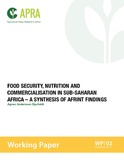| dc.contributor.author | Andersson Djurfeldt, Agnes | |
| dc.coverage.spatial | Ghana | en |
| dc.coverage.spatial | Kenya | en |
| dc.coverage.spatial | Malawi | en |
| dc.coverage.spatial | Mozambique | en |
| dc.coverage.spatial | Tanzania | en |
| dc.coverage.spatial | Zambia | en |
| dc.date.accessioned | 2018-02-19T14:54:06Z | |
| dc.date.available | 2018-02-19T14:54:06Z | |
| dc.date.issued | 2017-09-01 | |
| dc.identifier.citation | Andersson Djurfeldt, Agnes. (2017) ‘Food Security, Nutrition and Commercialisation in sub-Saharan Africa – a Synthesis of Afrint Findings’ APRA Working Paper 2, Future Agricultures Consortium | en |
| dc.identifier.isbn | 978-1-78118-421-9 | |
| dc.identifier.uri | https://opendocs.ids.ac.uk/opendocs/handle/20.500.12413/13565 | |
| dc.description.abstract | While macro-level data as well as sub-sector studies
across a number of African countries suggest
improvements in agricultural production over the
past couple of decades, the extent to which such
growth has been based on smallholder production
and, as such, has affected smallholder food security
and commercialisation is unknown (Wiggins, Keats
and Sumberg 2015). The potential for evaluating the
possibilities for pro-poor agricultural growth and the
commercialisation pathways tied to such growth is
hampered by a lack of longitudinal data that traces the
evolution of smallholder consumption, food security,
nutritional diversity and commercialisation over time.
Moreover, while the regional (and sometimes even local)
prospects for production as well as commercialisation
are reported to vary widely, a regional
approach to pro-poor agricultural growth is seldom
taken. Finally, although studies of gendered time-use
in agricultural production and its nutritional outcomes
exist, few studies consider the
links between food security, gender and pathways of
commercialisation. This paper does not therefore focus
on production as such, but explores the connection
between commercialisation and food security. The
analysis is based primarily on descriptive statistics; it
does not aim to explore causal relations but rather to
assemble data to elucidate changes over time in crosssectional
patterns.
The paper uses data from the Afrint database covering
roughly 2,100 smallholders in six African countries:
Ghana, Kenya, Malawi, Mozambique, Tanzania and
Zambia, surveyed in 2002, 2008 and 2013. It addresses
key aspects of food and nutrition security and their
linkages to commercialisation. Following a presentation
of the data at the country level, regional comparisons
will be made, discussing the linkages between food
security outcomes and particular commercialisation
pathways for the final wave of panel data (2008–13). | en |
| dc.description.sponsorship | ESRC | en |
| dc.language.iso | en | en |
| dc.publisher | APRA, Future Agricultures Consortium | en |
| dc.relation.ispartofseries | APRA Working Papers;2 | |
| dc.rights.uri | http://creativecommons.org/licenses/by-nc-nd/3.0/ | en |
| dc.subject | Agriculture | en |
| dc.subject | Development Policy | en |
| dc.subject | Economic Development | en |
| dc.subject | Gender | en |
| dc.subject | Nutrition | en |
| dc.subject | Poverty | en |
| dc.subject | Rural Development | en |
| dc.title | Food Security, Nutrition and Commercialisation in sub-Saharan Africa – a Synthesis of Afrint Findings | en |
| dc.title.alternative | Working Paper 2 | en |
| dc.type | Series paper (non-IDS) | en |
| dc.rights.holder | APRA, Future Agricultures Consortium | en |
| dc.identifier.team | Rural Futures | en |
| dcterms.dateAccepted | 2017-09-01 | |
| rioxxterms.funder | Department for International Development, UK Government | en |
| rioxxterms.identifier.project | APRA | en |
| rioxxterms.version | NA | en |
| rioxxterms.funder.project | e1f6d3be-457a-4f13-8b1f-6748d1402d83 | en |


